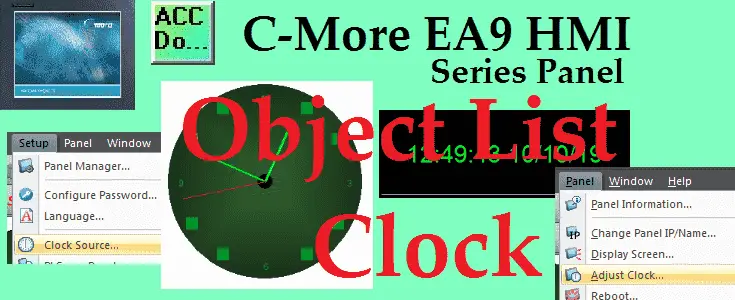We will now look at the C-More real-time clock object. The C-More HMI Panel software uses virtual components called Objects. These objects are programmable to simulate the functions that you require on your automation project. Pushbuttons, Switches, meters, and graphs are just a few of the objects that are available to you.
The Clock Objects includes a couple of options to customize the display of a real-time clock (RTC) on a screen.
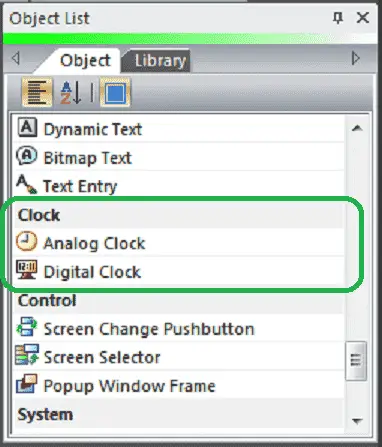
We will now look at the object list clock that we can use with our HMI panel. The clock objects that are available on the C-More EA9 are analog and digital. We will program each of these text objects. The source for the RTC clock will also be discussed and programmed both externally and internally. Let’s get started.
Previously in this C-More EA9 HMI Panel series, we have done the following:
System Hardware
– Unboxing and Review Video
– Powering the Unit Video
Installing the Software – Video
System Setup Screens – Video
First Program
– Establishing Communication and Updating Firmware Video
– First Program Video
Panel to PLC and PLC to Panel Settings – Video
Common Screen Menu – Video
Simulate Project – Video
Object List Shapes – Video
Object List Buttons – Video
Object List Indicators – Video
Object List Entry – Video
Object List Meters and Graphs – Video
Object List Bitmaps – Video
Object List Recipe – Video
Define Custom Keypad – Video
Object List Alarms – Video
Object List Text – Video
Watch the video below to see the Object List Clock in action on our C-More EA9 HMI Panel.
Setting Our Clock Screen – C-More EA9
We will be adding to the program we created last time. (C-More EA9 HMI Series Panel Object List Text).
Select new screen, under the main menu | Screen | New Screen…
Alternatively, we can also use the icons in the Navigation panel.

We will name the screen 14 Clock. The screen description can be used to describe the screen. Hit OK.
Our new screen will now be displayed.
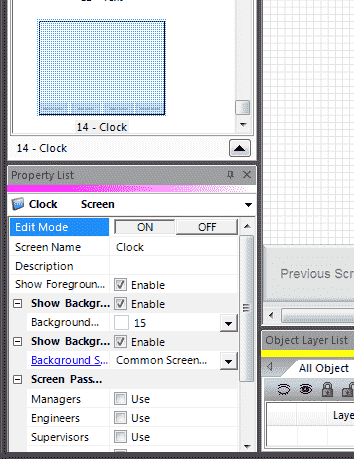
Under the property list window, turn on the editing and enable the show background. Select Common Screen Menu under the background screen. Turn off the edit mode under the property list.

We must now add our new screen so we can select it when using the common screen menu. Select page 100. Select the Screen Selector button. Under the Screen tab, select the 14 – Clock and hit the Add button so it moves it over to the Current Screen Buttons. Hit OK. We can now go back to our newly created Object Clock screen page 14 from our navigation window.
Our new screen is now ready for us to add our clock objects.
Tag Name Database – C-More
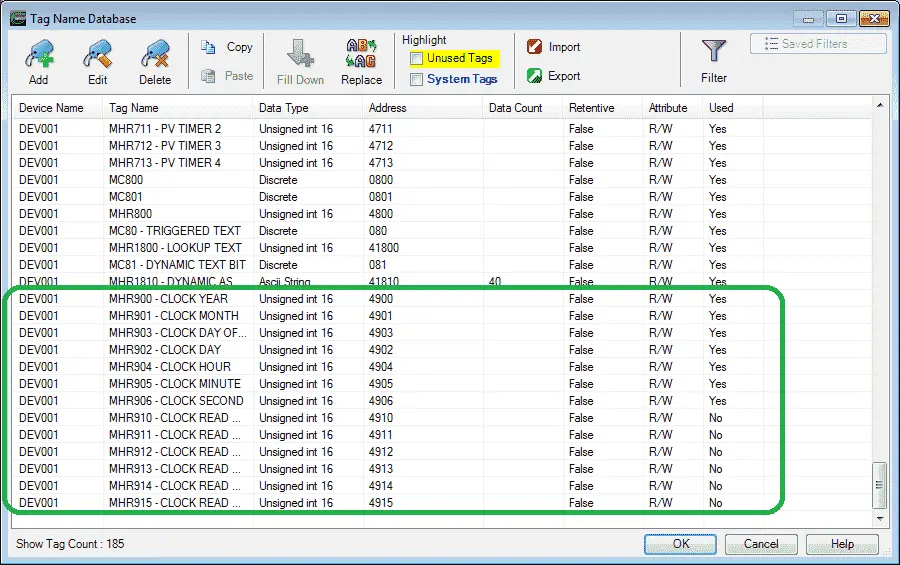
We will use the following addresses for internal/external locations for the clock objects on our cmore HMI.
MHR900 – Unsigned Int 16 – Modbus Address 40900 – Read / Write (Internal)
MHR901 – Unsigned Int 16 – Modbus Address 40901 – Read / Write (Internal)
MHR902 – Unsigned Int 16 – Modbus Address 40902 – Read / Write (Internal)
MHR903 – Unsigned Int 16 – Modbus Address 40903 – Read / Write (Internal)
MHR904 – Unsigned Int 16 – Modbus Address 40904 – Read / Write (Internal)
MHR905 – Unsigned Int 16 – Modbus Address 40905 – Read / Write (Internal)
MHR906 – Unsigned Int 16 – Modbus Address 40906 – Read / Write (Internal)
MHR910 – Unsigned Int 16 – Modbus Address 40910 – Read / Write (External)
MHR911 – Unsigned Int 16 – Modbus Address 40911 – Read / Write (External)
MHR912 – Unsigned Int 16 – Modbus Address 40912 – Read / Write (External)
MHR913 – Unsigned Int 16 – Modbus Address 40913 – Read / Write (External)
MHR914 – Unsigned Int 16 – Modbus Address 40914 – Read / Write (External)
MHR915 – Unsigned Int 16 – Modbus Address 40915 – Read / Write (External)
Analog Clock – C-More EA9
The analog clock object is used to display a clock that will indicate the real-time information to the operator.

Select Screen 14 from the navigation window. We will now add an Analog Clock under the Clock heading in the Object list window. Click the Analog Clock. Left-click (hold) and drag the Green-1 from the Parts List onto the screen.
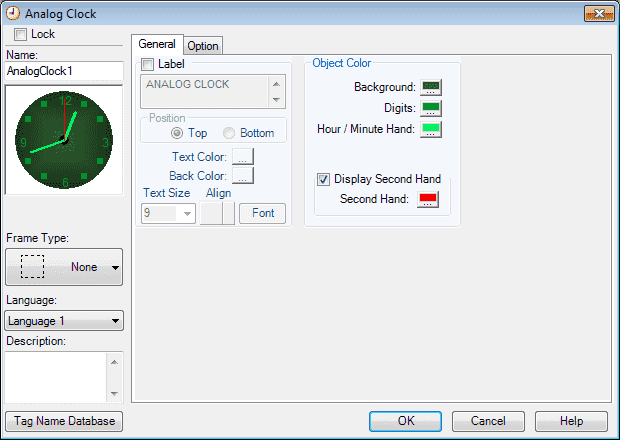
The Analog Clock window will display. You can also use the main menu | Object | Clock | Analog Clock… and click on the work area of the screen. This will give you the default selection.
This window will allow you to change the look of the clock on the screen. Click the Options tab.

We can set the visibility of the Analog Clock. In our case, we will not set this parameter. Select OK
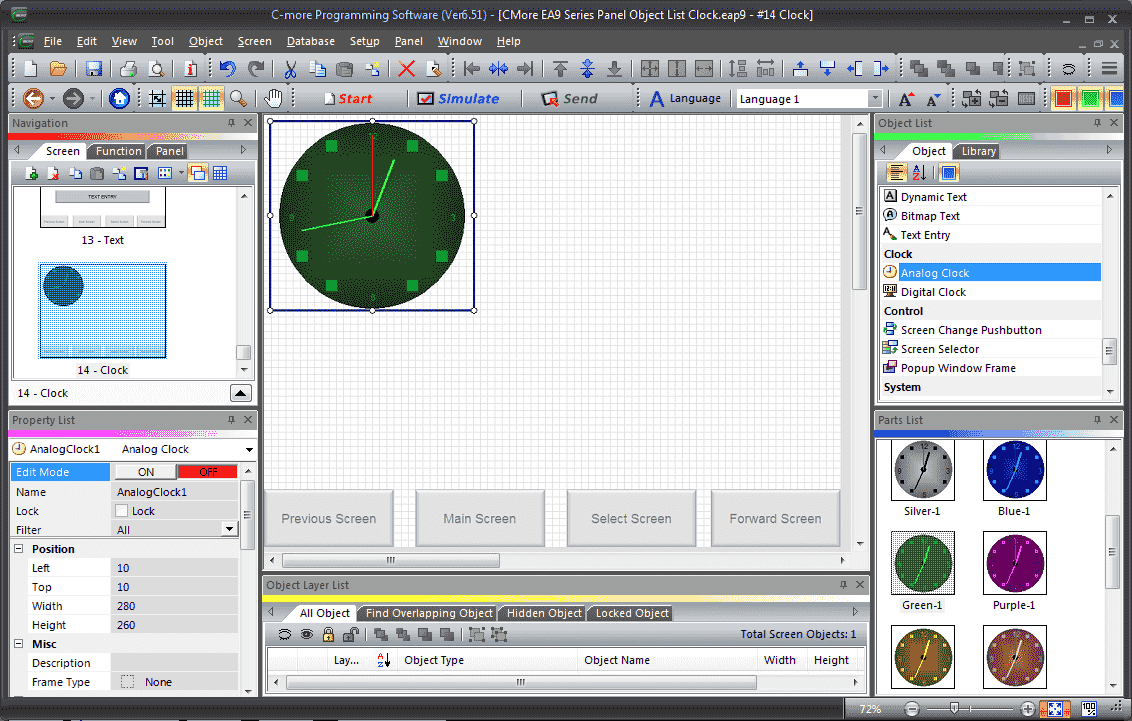
We can now use the mouse to size and position our analog clock on the screen.
Digital Clock – C-More EA9
The digital clock object is used to display a clock that will indicate the real-time and date information to the operator.
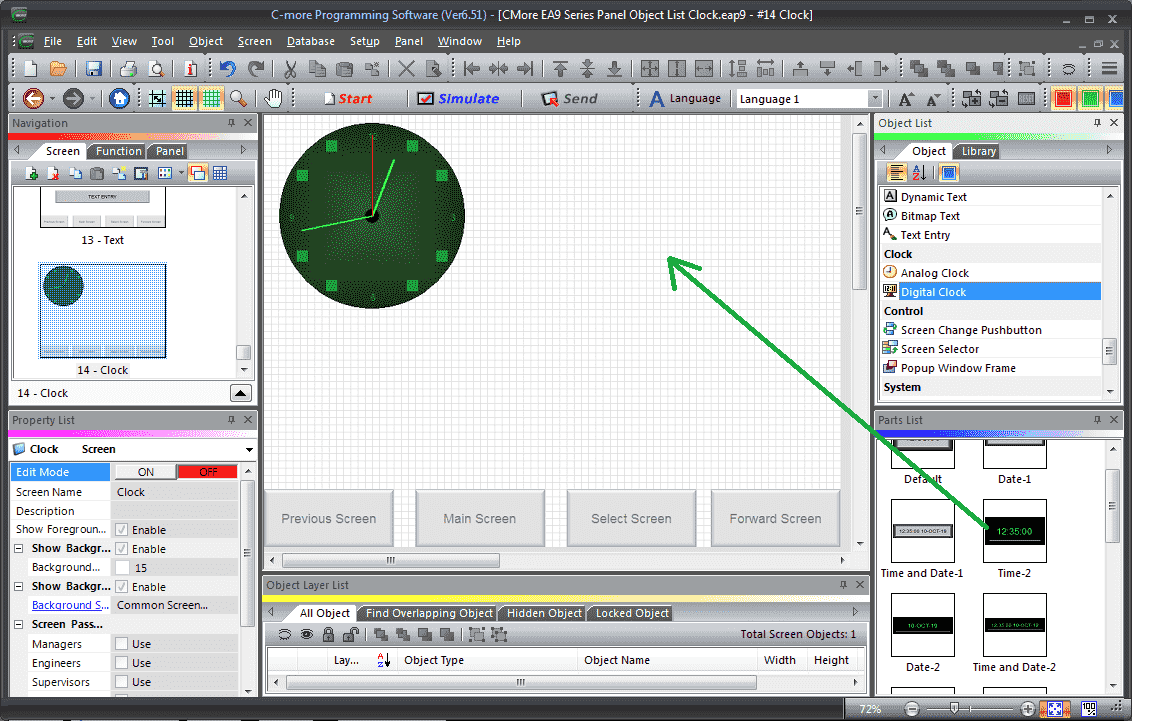
We will now add a Digital Clock under the Clock heading in the Object list window. Click the Digital Clock. Left-click (hold) and drag the Time-2 from the Parts List onto the screen.

The Digital Clock window will display. You can also use the main menu | Object | Clock | Digital Clock… and click on the work area of the screen. This will give you the default selection.
Under the Clock Display heading, select Time and Date. Select a text size of 24 so we can see the real-time information clearly on the HMI screen.
Select the options tab.

We can set the visibility of the Digital Clock. In our case, we will not set this parameter. Select OK
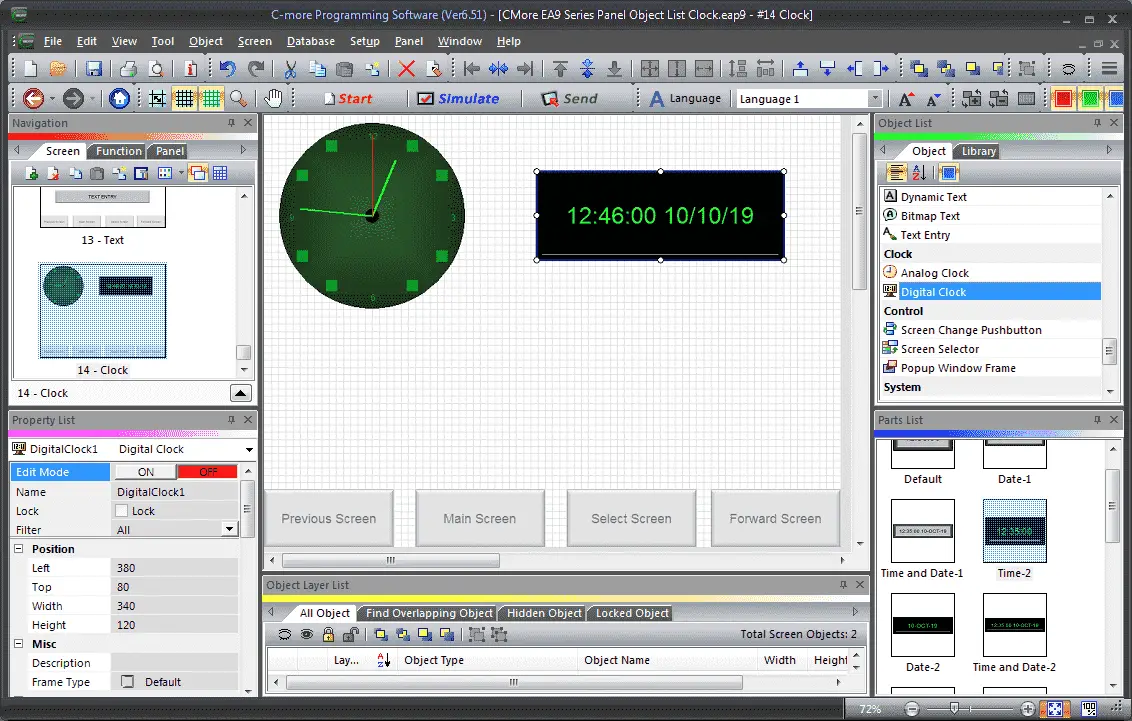
We can now use the mouse to size and position our Digital Clock on the screen.
Simulation – C-More EA9 Clock
We can simulate our HMI program to ensure that we have the screen look that we want.
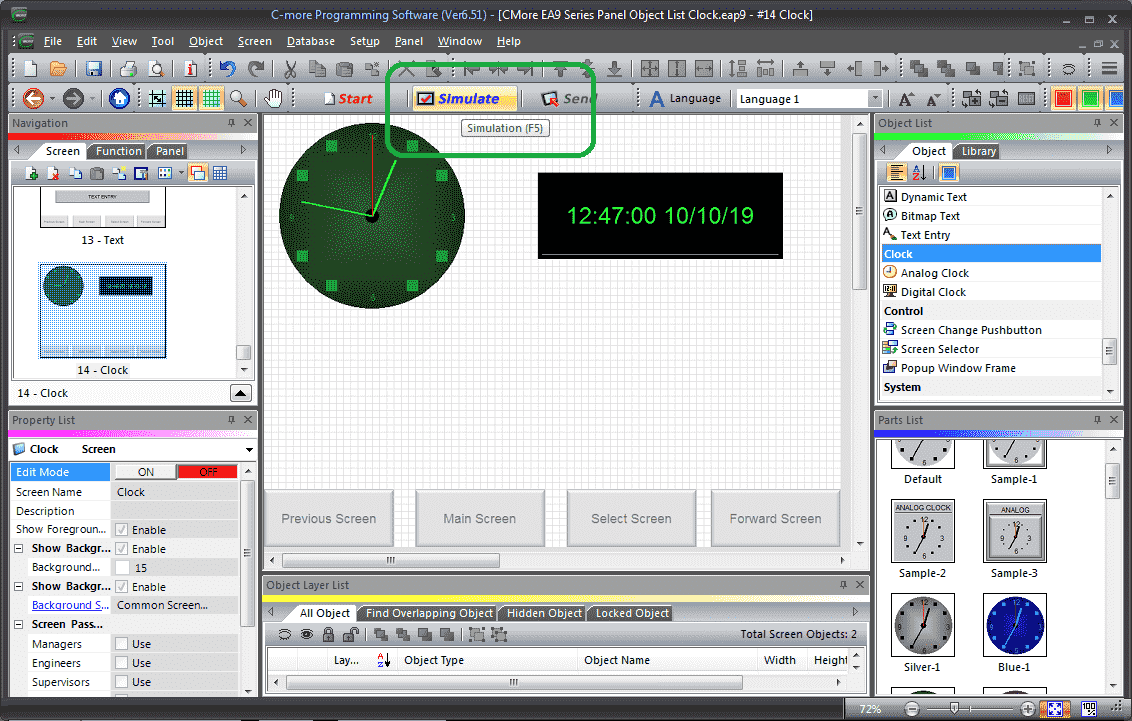
Select the F5 to start the simulation or select the Simulate icon from the main menu.
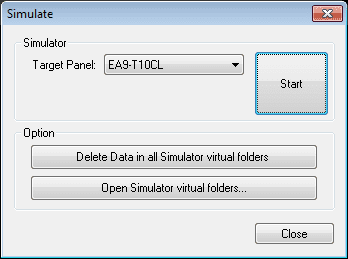
The target panel will default to the current version of C-more that you are programming. Select Start.

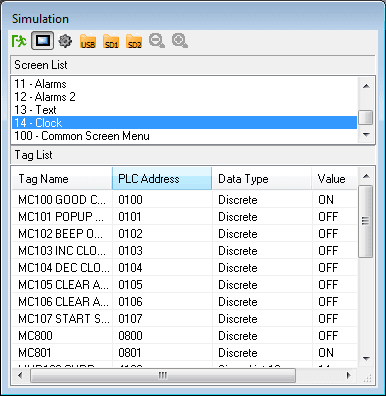
We can now operate the HMI screen for functionality.
See the video below to see the HMI in action with our clock object selections.
Clock Source Internal
When the RTC is set to internal, the HMI panel will retain the current time and date from the built-in real-time clock.
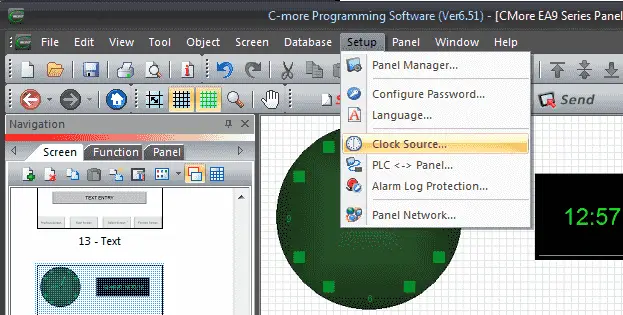
Select clock source using the main menu | Setup | Clock Source…
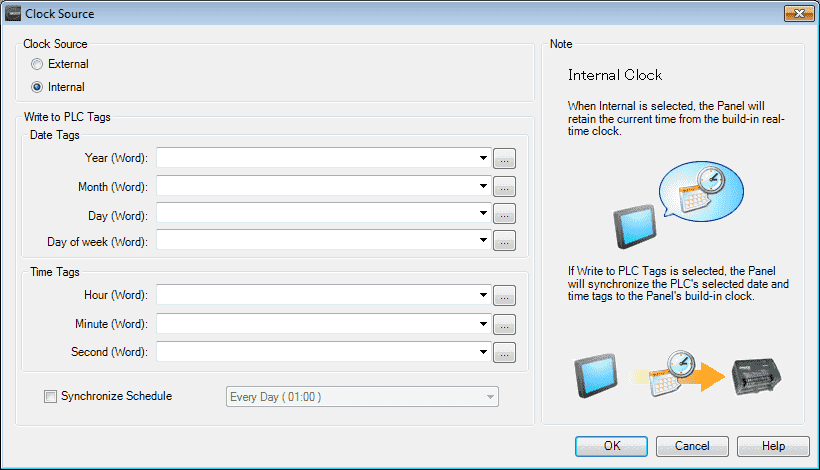
The clock source window will now appear.
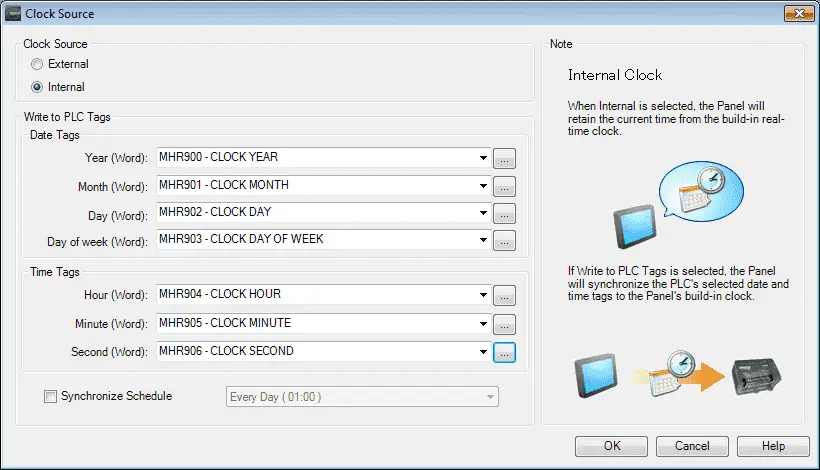
We will fill in the following tags to write the real-time and date into the PLC.

Using the Data View of the Do-More Designer software we can monitor the registers that the HMI is setting. (MHR900 to MHR906)
Clock Source External
When the RTC is set to external, the HMI panel will read the date and time tags that have been specified and use them as the real-time clock.
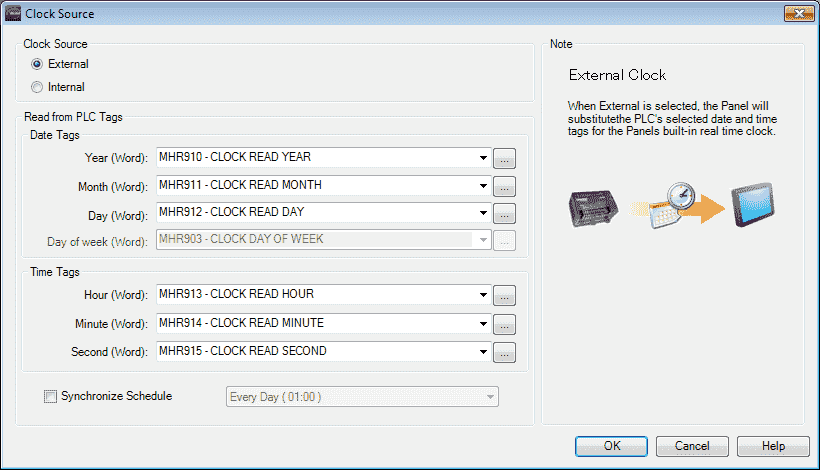
MHR910 to MHR915 is being used as the real-time clock. We will have to create a program to ensure that the information contained in the registers contain the information needed. This will be 16-bit unsigned registers. See the help file on the CMore Software for more information.
Program Additions
Using the program we previously developed, we will add additional rungs to the program for our Clock External References.
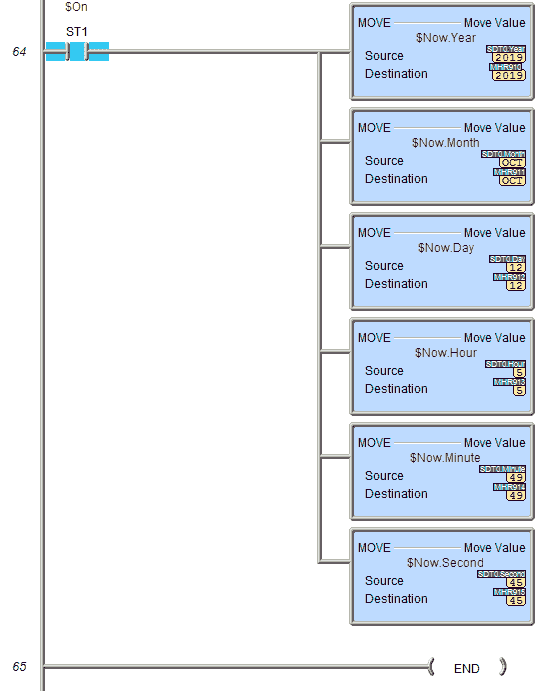
ST1 is the always-on bit that will move the real-time clock time and date into the registers programmed on the HMI.
See the video below to see the External and Internal references in action with our clock object.
C-More Adjust Clock
The Adjust Clock selection will change set the internal real-time clock. This can be a custom setting or taken from the windows PC that you are using to program the C-More HMI panel.

Select from the main menu | Panel | Adjust Clock…
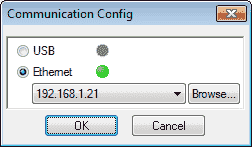
You must have the ability to communicate with the C-More HMI in order to adjust the clock. Click OK.
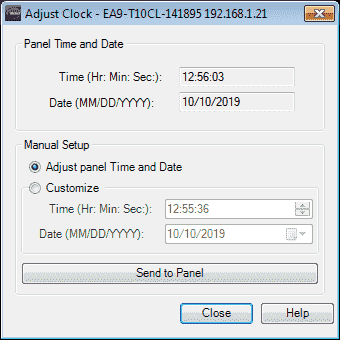
The Adjust Clock window will now be displayed. You can now adjust panel Time and Date to use the computer RTC or select Customize. Customize will allow you to manually set the RTC.
Select Send to Panel to send the RTC parameters to the C-More internal clock values.
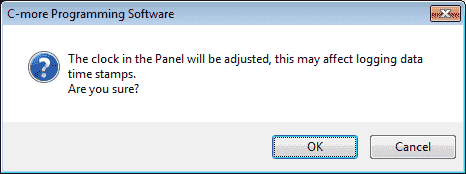
A warning window will be displayed indicating that the clock in the panel will be adjusted. This may affect logging data time stamps. Select OK.

Your new time and date will now be placed in the internal C-More Clock.
Download the PLC and C-More program here.
Watch the video below to see the Clock Objects in action on our C-More EA9 HMI Panel. This will also demonstrate the internal and external clock source.
C-More EA9 Panels from Automation Direct
https://www.automationdirect.com/adc/overview/catalog/hmi_(human_machine_interface)/c-more_touch_panels_ea9_series
C-More – Graphic Panel (EA9 Series) User Manual and Quick Start Guides
https://cdn.automationdirect.com/static/manuals/ea9userm/ea9userm.html
EA9-T10CL C-More Specifications
https://cdn.automationdirect.com/static/specs/ea9t10cl.pdf
C-More EA9 Programming Software (Current Version V6.42)
https://support.automationdirect.com/products/cmore.html
This software will enable you to program all of the C-More EA9 HMI units. It includes a simulator for your application.
Next time we will look at a Barcode Scanner input to our C-More HMI Panel.
Watch on YouTube: C-More EA9 HMI Series Panel Object List Clock
If you have any questions or need further information please contact me.
Thank you,
Garry
If you’re like most of my readers, you’re committed to learning about technology. Numbering systems used in PLC’s are not difficult to learn and understand. We will walk through the numbering systems used in PLCs. This includes Bits, Decimal, Hexadecimal, ASCII and Floating Point.
To get this free article, subscribe to my free email newsletter.
Use the information to inform other people how numbering systems work. Sign up now.
The ‘Robust Data Logging for Free’ eBook is also available as a free download. The link is included when you subscribe to ACC Automation.

